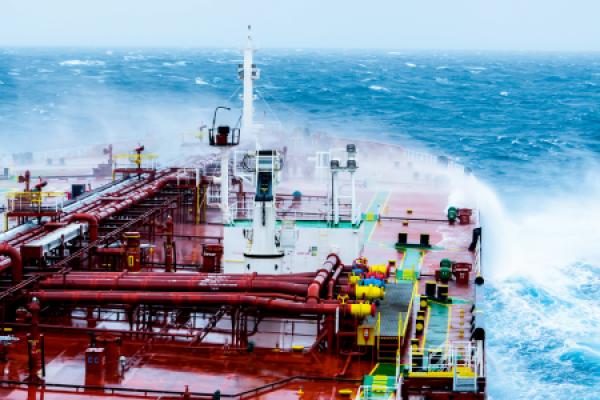
Nahush Paranjpye
Published: March 12, 2025
Introduction
The decision to stay in port or to sail out to sea to ride out a storm is not always straightforward and requires careful consideration of factors such as location of the port/berth, its characteristics, its condition and operational status, intended or ongoing activities, local environmental conditions, and other influencing factors. Similarly, it is important to consider associated risks when vessels are near or approaching a port in adverse weather or where adverse weather conditions are forecast.
This Risk Alert is intended to highlight some of these considerations from a loss prevention perspective. It should not be considered as displacing the Master’s obligations under the ISM Code, as the Master will always have the overall responsibility to make decisions with respect to safety and pollution prevention for the vessel.
Considerations
As per the ISM code:
“Master has the overriding authority and the responsibility to make decisions with respect to safety and pollution prevention and to request the Company's assistance as may be necessary”.
A shipmaster is expected to act reasonably in exercising their authority without placing the ship, its crew, cargo and the marine environment in a position of peril where the danger is known and can be avoided.
A ship might enter a port where conditions were safe at its entry but subsequently became unsafe due to an adverse weather forecast or warning. Similarly, situations may change close to a port arrival or departure.
Monitoring influencing factors is essential in deciding when to sail out from a port if adverse weather conditions are expected. The dynamic nature of weather warnings, vessel operational conditions, and other factors will influence the master's decisions. The vessel's weathertightness and watertightness are important factors and due consideration must be given to all adverse weather checks to ensure the vessel's integrity and safety are not compromised.
Relevant considerations for the vessel’s safe operation in the port include: location (anchorage, mooring buoy, berth, dry-dock), type of operation, windage area, engine readiness, proximity of other ships, visibility, effect of wind speed and direction, state of tide and swell, currents, ship’s draft in relation to the under keel clearance, available sea-room, manoeuvrability capabilities, and forecast weather conditions (eg. typhoons, cyclones, hurricanes, tornadoes, rainstorms, hailstorms, snowstorms, dust storms, tidal surges, high tidal variations, tsunami warnings and sea ice, among others). These conditions will affect the vessel’s motion when alongside in a port and may impose heavy loads/stresses on the mooring lines. Similarly, anchor recovery operations during heavy rolling/pitching motions may lead to anchor chain failure, loss of anchor, failure to heave up anchor and hull damage. An impact with an anchor chain leading under the hull could pose a hazard to the hull’s integrity.
The topography of the land surrounding a port may also give rise to conditions such as katabatic/anabatic winds, or the layout of the port and its breakwater may leave specific berths, or the entire port, exposed to winds/waves coming from a particular direction.
Windage areas significantly impact vessels such as container, passenger, livestock and vehicle carriers. Low freeboard vessels such as bulk carriers and tankers may also offer a considerable windage area when in ballast condition; therefore, wind speed and direction are important considerations in a port and may be limiting factors in safe cargo operations.
Ports around the globe generally have their own safe operation requirements. These guidelines set out baselines on the factors that may affect safety, such as the types of operations which can be carried out safely when a vessel is in port if there are any limitations due to weather conditions. These can be conveyed through alerts via VHF, phone, lights, shapes or sound signals, email messages or other channels, and can also advise on appropriate actions such as requiring ships to sail to open waters if there is a forecast of strong winds beyond safe limits assessed by the port.
Guides to port entry, sailing directions, tide tables, tidal stream atlases, routeing charts, nautical charts, weather forecasts and open-source information on a port’s official website are some of the familiar sources of reliable information available to mariners that may help in conducting a preliminary risk assessment when planning a port call. Updated and more detailed local information is usually obtainable through local agents and from official sources of information specific to the port.
The Master-Pilot exchange (MPX) of information can often shed more light on the nuances that may be expected at certain berths or other locations within the port limits, along with any relevant information based on the local Pilot’s experience.
Recommendations:
Every vessel possesses distinct manoeuvring capabilities and characteristics, and their responses to adverse weather conditions can vary significantly. The standard course of action when heavy weather is forecast has been to sail out to sea and ride out the storm while underway. However, it is important to understand that this approach is not always the safest option. In many cases, seeking refuge in a port provides a far more secure option against severe weather. This may be truer for vessels operating on coastal or inter-island voyages or vessels not designed and fitted for ocean going voyages. The availability of a safe harbour that offers shelter from the weather may thus be an important consideration.
Any decision to leave the port in response to adverse conditions should be made well in advance and be backed by a reasonable assessment by the Master.
Any demobilisation for servicing, repairs, or other activities when in port, may require prior permission from a port authority as this could affect the vessel’s readiness to depart port.
It is essential that weather monitoring (current and forecast weather) is part of the vessel’s port keeping routine. It is recommended that all material evidence be retained to help support any defence against a potential claim. Such evidence could include alerts or instructions issued by the port, vessel’s records, any communications on the subject, operations logs, weather monitoring records, weather forecasts, and any other supporting information, including audio/visual evidence.
Members are encouraged to include appropriate guidance in their safety management system procedures to assist Masters in making decisions and taking action, including guidance on reporting and data collection.
Safety should be always given priority above commercial considerations
The above general guidance supplements other widely available industry guidance not addressed in this risk alert.
Supportive Information
For further information on this or other Loss Prevention topics please contact the Loss Prevention Department, Steamship Insurance Management Services Ltd.
Tel: +44 20 7247 5490; Email: [email protected]
Resources
Severe Weather Information Centre 3.0 (World Meteorological Organisation)
Risk Alert 112


